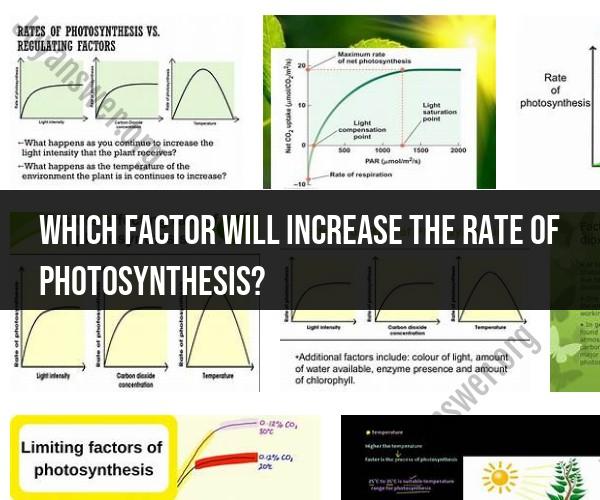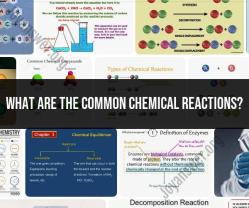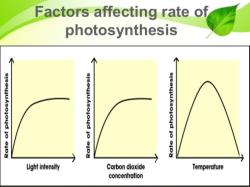Which factor will increase the rate of photosynthesis?
Photosynthesis is a complex biochemical process by which green plants, algae, and some bacteria convert light energy, typically from the sun, into chemical energy in the form of glucose and oxygen. Several factors can influence and increase the rate of photosynthesis:
Light Intensity: Increased light intensity generally leads to a higher rate of photosynthesis. However, there's an optimal light level for each type of plant beyond which photosynthesis may not increase further (light saturation point).
Carbon Dioxide (CO2) Concentration: A higher concentration of carbon dioxide can increase the rate of photosynthesis because CO2 is one of the reactants in the process. Plants in environments with elevated CO2 levels, such as a greenhouse, can often photosynthesize more efficiently.
Temperature: Photosynthesis is temperature-dependent, and it generally increases as temperature rises up to a certain point (usually around 25-30°C for most plants). Beyond this optimal temperature range, the rate of photosynthesis can decline due to enzyme denaturation.
Water Availability: Sufficient water is necessary for photosynthesis because it's involved in the transport of nutrients and maintaining the plant's turgidity. Water stress or drought can reduce photosynthetic rates.
Nutrient Availability: Essential nutrients, particularly nitrogen, phosphorus, and potassium (NPK), as well as trace minerals, are required for plant growth and photosynthesis. A deficiency in any of these nutrients can limit photosynthesis.
Chlorophyll Content: Chlorophyll, the pigment responsible for capturing light energy, plays a crucial role in photosynthesis. Plants with more chlorophyll are generally better at photosynthesis.
Leaf Surface Area: A larger leaf surface area provides more space for the absorption of light and exchange of gases (CO2 and O2), which can increase the rate of photosynthesis.
Enzyme Activity: Photosynthesis relies on enzymes, such as ribulose-1,5-bisphosphate carboxylase/oxygenase (RuBisCO). Optimal enzyme activity is crucial for efficient photosynthesis.
Light Quality: Plants utilize different wavelengths of light for photosynthesis. Blue and red light are particularly important for photosynthesis, while green light is less effective because it's often reflected.
Genetics and Species Variability: Different plant species have varying photosynthetic capabilities and respond differently to environmental factors. Some species are adapted to low-light conditions, while others thrive in high-light environments.
Oxygen Concentration: A higher concentration of oxygen can inhibit photosynthesis in certain circumstances because oxygen can compete with carbon dioxide for the active site of RuBisCO, leading to a process called photorespiration.
Environmental Stressors: Factors such as pollution, diseases, and herbivore damage can reduce the rate of photosynthesis by disrupting normal physiological processes.
It's important to note that these factors often interact with each other, and the rate of photosynthesis is limited by the factor that is in the shortest supply. Additionally, different plants and species have unique responses to these factors, so what increases photosynthesis in one species may not have the same effect in another. Optimizing these conditions in controlled environments (e.g., greenhouses) can be a strategy to enhance crop productivity.
Factors that Boost Photosynthesis Rate: Unveiling the Secrets
Photosynthesis is the process by which plants use sunlight, water, and carbon dioxide to create oxygen and energy in the form of sugar. The rate of photosynthesis can be affected by a number of factors, including:
- Light intensity: Light is the energy source for photosynthesis, so the greater the light intensity, the faster the rate of photosynthesis.
- Carbon dioxide concentration: Carbon dioxide is a reactant in photosynthesis, so the higher the carbon dioxide concentration, the faster the rate of photosynthesis.
- Temperature: Temperature affects the rate of enzyme activity, which is essential for photosynthesis. The optimal temperature for photosynthesis varies depending on the plant species, but it is generally between 20 and 30 degrees Celsius.
- Water availability: Water is a reactant in photosynthesis and is also needed to transport nutrients to and from the leaves. If a plant is not getting enough water, the rate of photosynthesis will decrease.
- Nutrient availability: Plants need a variety of nutrients for photosynthesis, including nitrogen, phosphorus, and potassium. If a plant is deficient in any of these nutrients, the rate of photosynthesis will decrease.
In addition to these environmental factors, the rate of photosynthesis can also be affected by the plant's genetics and the structure of its leaves.
Enhancing Photosynthesis: What Factors Contribute to Faster Growth?
There are a number of things that can be done to enhance photosynthesis and promote faster growth in plants. These include:
- Providing adequate light: Plants need at least six hours of sunlight per day to photosynthesize effectively. If plants are not getting enough light, they can be placed under grow lights.
- Maintaining optimal temperature and humidity: The optimal temperature and humidity for photosynthesis varies depending on the plant species, but it is generally between 20 and 30 degrees Celsius and 40 and 60 percent, respectively.
- Providing adequate water and nutrients: Plants need a regular supply of water and nutrients to photosynthesize effectively. Water and nutrients can be provided through irrigation and fertilization.
- Choosing the right plant species: Some plant species are more efficient at photosynthesis than others. When choosing plants for your garden, it is important to select species that are well-suited to your climate and growing conditions.
Accelerating Photosynthesis: Understanding the Rate-Increasing Elements
Scientists are also working on developing new ways to accelerate photosynthesis. One promising approach is to engineer plants to produce more of the enzymes that are involved in photosynthesis. Another approach is to develop new crop varieties that have leaves that are better at absorbing sunlight and carbon dioxide.
By understanding the factors that affect the rate of photosynthesis, we can develop new ways to enhance photosynthesis and promote faster growth in plants. This could help to increase crop yields and reduce the environmental impact of agriculture.












